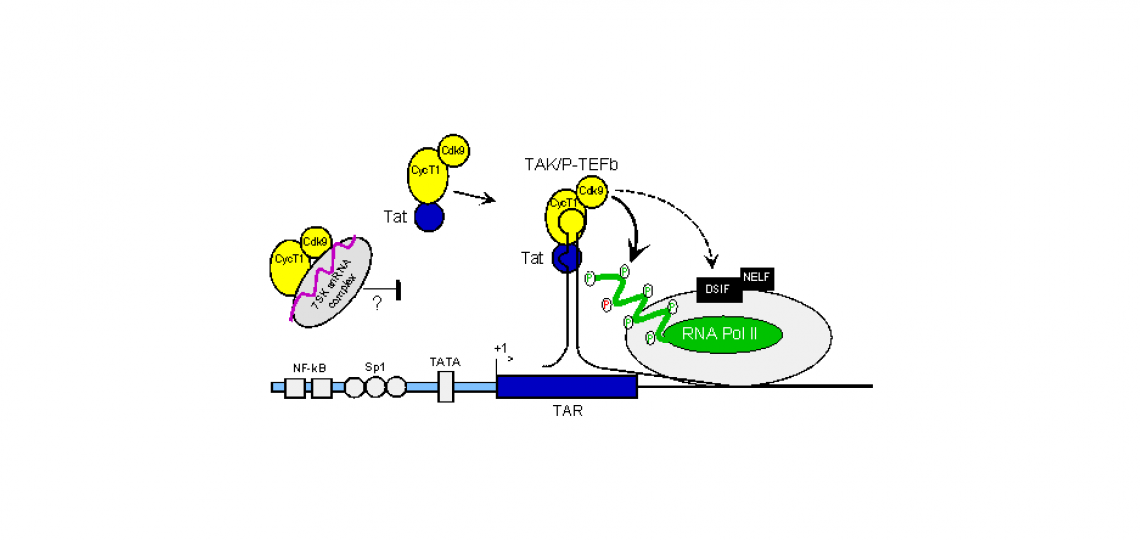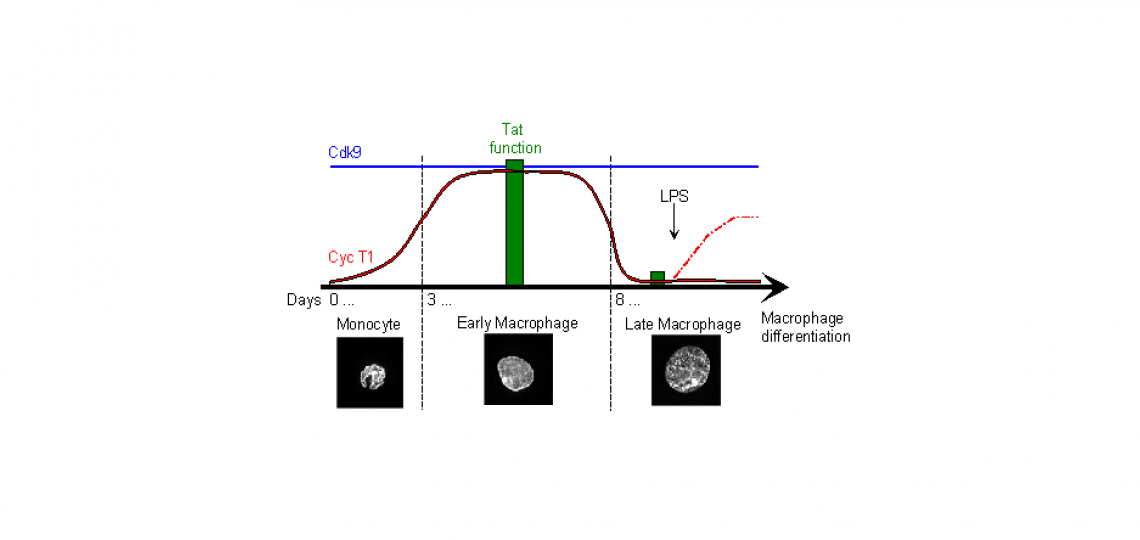Role of TAK/P-TEFb in Regulating HIV Gene Expression
Replication of HIV and efficient expression of HIV genes requires the function of a viral protein named Tat. Tat acts by greatly stimulating the elongation step of transcription and allowing expression from the full length of the viral genome. This function of Tat is mediated by a cellular protein kinase complex known as TAK/P-TEFb. TAK/P-TEFb is composed of a catalytic subunit, Cdk9, and a regulatory subunit, cyclin T1. Tat interacts directly with cyclin T1 and recruits TAK/P-TEFb to the viral RNA element named TAR that is located just downstream from the viral promoter. Once positioned near the beginning of the start site of transcription, the Cdk9 subunit hyperphosphorylates the carboxyl-terminal domain of the cellular RNA polymerase (Pol) II as well as negative elongation factors. Phosphorylation of the RNA Pol II complex relieves the block to transcription elongation, and the modified RNA Pol II complex is capable of fully transcribing the viral genome and allowing expression of the viral gene products. Therefore, the role of TAK/P-TEFb is critical in regulating expression of HIV.

Model for the mechanism of regulation of HIV expression by TAK/P-TEFb. (Modified from Rice & Herrmann, Current HIV Research, 2003, 1,395-404. With permission from Bentham Science Publishers Ltd.)
Regulation of TAK/P-TEFb in Primary Lymphocytes and Macrophages
The major cell types that are targets of infection by HIV are CD4+ T cells and macrophages. Because TAK/P-TEFb activity controls HIV replication, it is important to understand how TAK/P-TEFb is regulated in these cell types. In T cells, the protein levels of the TAK/P-TEFb subunits Cdk9 and cyclin T1 and its kinase activity are very low in resting cells, but the protein levels and kinase activity increase when the cells are stimulated. The increase in TAK/P-TEFb activity following activation of the cells correlates with the increased ability of HIV to replicate in stimulated cells. The mechanism of TAK/P-TEFb regulation is somewhat different in macrophages, cells that play an important role in the innate immune response. Monocytes freshly isolated from human blood do not efficiently support HIV replication, but following differentiation in culture to macrophages become more susceptible to HIV infection. While Cdk9 levels are high in both monocytes and macrophages, cyclin T1 levels are induced following differentiation to macrophages. The levels of cyclin T1 correlate with Tat activity. Our laboratory is actively studying signals and mechanisms that regulate TAK/P-TEFb function in these cell types that are natural targets of HIV infection.

Regulation of cyclin T1 expression and Tat activity during macrophage differentiation. (From Rice & Herrmann, Current HIV Research, 2003, 1,395-404. With permission from Bentham Science Publishers Ltd.)
Regulation of TAK/P-TEFb by 7SK snRNA/HEXIM1
The abundant 7SK small nuclear (sn) RNA and the protein HEXIM1 have been shown to associate with P-TEFb, and this association has been proposed to negatively regulate P-TEFb activity. We have been studying the regulation of 7SK snRNA/HEXIM1 expression and association with P-TEFb in primary lymphocytes and macrophages. In lymphocytes, the level of 7SK snRNA and its association with P-TEFb increases following activation. Because P-TEFb activity also increases in activated T lymphocytes, this result appears inconsistent with the idea that the 7SK snRNA/HEXIM1 complex negatively regulates P-TEFb activity. We are using short interfering (si) RNA technology to knockdown 7SK snRNA expression to further probe the role of 7SK snRNA/HEXIM1 in regulating P-TEFb activity.
Subcellular Localization of TAK/P-TEFb Subunits
Cells are organized into functional compartments. The most obvious compartments are the nucleus and cytoplasm, which are spatially separated by the nuclear membrane and in which the functions of transcription and translation occur respectively. The nucleus is further compartmentalized in functionally distinct regions. The subcellular localization of proteins can therefore provide information as to the function of proteins. The distribution of the TAK/P-TEFb subunits, Cdk9 and cyclin T1 was analyzed using immunofluorescence and high resolution deconvolution microscopy. Both proteins reside in the nucleus and are enriched in a subnuclear compartment referred to as splicing factor compartments (or speckles) which contain high concentrations of splicing factors. Because the processes of transcription elongation and pre-mRNA processing are coordinated, this may indicate that TAK/P-TEFb plays a role in linking these two processes. We are studying the relationship between the function of TAK/P-TEFb and the spatial distribution of Cdk9 and cyclin T1 and associated factors within the context of the host cell nucleus

Colocalization of Cdk9 (green), cyclin T1 (red), and SC35 (blue) in HeLa cells. (Images by C. Herrmann)







